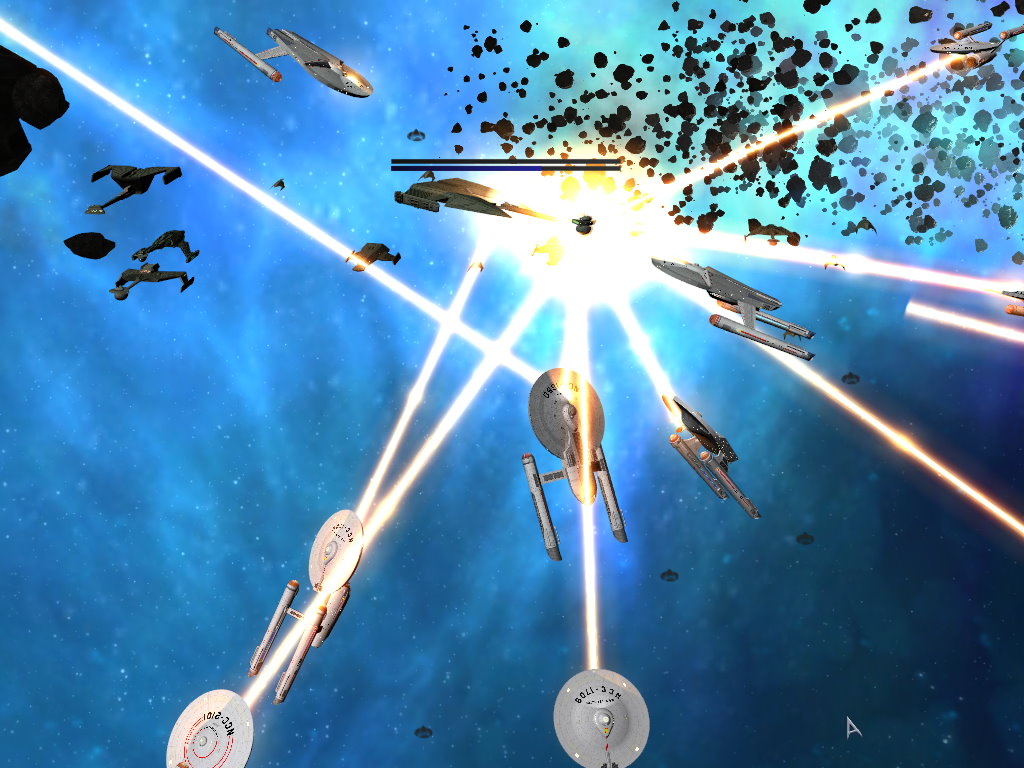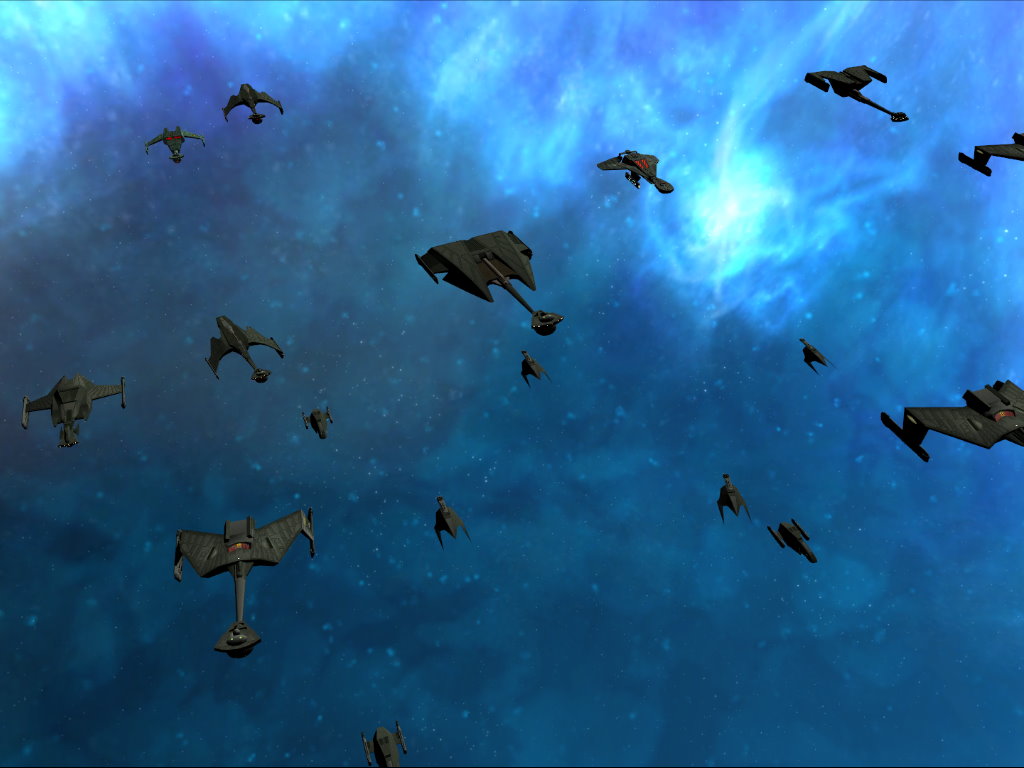I had to realize that I simply don’t have enough time to make a DD every month, because I don’t make enough progress. And because writing one takes too much time from the mod. So I decided to post something when I feel like having something to show you.
I can report now that modeling is done, short of one Federation ship, which is why can’t I introduce the other new ship class of War-Aftermath. I started working on the balance, but it’s all Excel tables and formulae, nothing interesting to show. Instead, I’m going to talk about the history of this new Era.
Let’s pick up the chain of events where Federation Dawn left off. It’s the middle of the General War and two iconic ships just entered service: the Federation Constitution Class and the Klingon K’t’agga Class (you may know it as the D7 Class, more on that later). Let’s stop right here and ask, which one is the most significant starship of the Genera War? Most of you would say one of the two above, but historians say the correct answer is the Valley Forge Class, the first modular starship.
Modular starship construction was a radical development. While previously one shipyard built one starship from laying the keel until leaving drydock, modular construction meant that pre-built starship modules could be shipped to the shipyard where the starship could be assembled in a couple of weeks instead of months. This method soon became standard for both sides, the Federation built a whole series of starship on pre-fabricated modules.
This had a huge impact on space warfare. A combat situation mostly meant one-on-one skirmishes, or possibly a handful of ships vs a handful of other ships. But in a few months the number of participating ships tripled on each side. The impact was enormous. Consider it like knights fighting. If there are only the two of you, and you get wounded, you have a good chance to get away, because the other one may not want or dare to pursue you. Now imagine dozens of knights clashing. Even if you are wounded, you may not be able to flee, because you’ll meet another knight on the battlefield.
As a result, despite having more ships to filed, casualties rocketed on both sides, because damaged ships couldn’t retreat from the fight in time any more. But it didn’t matter that much because war economy made it possible to quickly reinforce decimated fleets.
Facing the growing list of lost ships, high command had to decide what to do, and the answer was the same on both sides. You have to destroy ships faster than your opponent. Improving shielding and armor takes serious toll in energy consumption and maneuverability, and it takes a lot of time to develop new technologies. However, it was relatively simple to improve the performance of the weapons. Interestingly it wasn’t the energy output that increased drastically, but the accuracy. During the war – despite the best efforts of ECM technologies – the targeting computers of energy weapons and guidance systems of projectiles saw a huge improvement, so ships were more effective in destroying each other, but not having an adequate shielding to counter the improved firepower.
Back to our two knights, imagine if instead of swords, they were fighting with guns. The fight would be over very quickly, most likely with one of them dead, without a chance of retreat, because the first hit could be fatal.
Another way was to simply create bigger ships, with stronger hull, more powerful shields and faster warp drives. Although we’ll see very few evidence of this in W-A, the later years of the General War was the beginning of what historians call the Size Race, when ships of size and power never seen before were developed (even though they rarely saw real action) and what eventually led to designs like the Excelsior, the Galaxy, the Sword of Khaless the Negh’Var or the D’Deridex Class.
This situation didn’t change until the end of the war, when suddenly and simultaneously the quadrant-wide economy crashed well under pre-war levels, an event coincided with the peace treaty of 2248. In retrospect may suspect the Organians being the ones orchestrating the treaty to avoid bigger chaos.
Anyhow, at the end of the war the parties found themselves with no economic background to replenish their fleets and few ships that could quickly destroy the enemy – or just as quickly could be destroyed.
Especially when the Interstellar Concordium made a daring – and in retrospect ridiculous – attempt to pacify the whole quadrant, and laid claim on all the unclaimed territories and on the Neutral Zones as well, to separate the warring parties. Without the proper firepower to support their claims and with the unanimous opposition of every party, their efforts were quickly cracked down, but not without further weakening the already exhausted fleets.
Coincidentally, the ISC’s action had a stabilizing effect on the Alpha Quadrant, even though the hostilities between the Klingons and the Federation restarted almost immediately and an almost fifty years period started called the Federation-Klingon Cold War. During this conflict, border skirmishes were often, but they also often ended in a diplomatic way, without exchanging fire. The conflict got hot on two occasions though.
The Four Years War, started in 2256, was historically a rather insignificant conflict. Fought on a much smaller scale, with far less ships, more cautious strategies and with only minor border changes, it did not influence the course of galactic history that much, except one thing: This was the conflict when James Kirk’s name became increasingly famous through the quadrant.
The Four Days War however has a more significant impact on history. When the Klingons launched an attack on Federation territory, the Organians openly intervened and stopped the conflict right after it started. The fact that there are powerful entities that may possess the power to wipe out a whole empire if they not behave had a very sobering effect on future conflicts.
Meanwhile, the Klingon-Romulan relations didn’t became as cool after the war as Starfleet Intelligence believed. Relations remained cordial and twenty years after the end of the General War, in 2267 an alliance was formed. That wouldn’t be anything new, the Federation also maintained a non-aggression pact with several minor parties. What made this alliance special was the technology exchange.
The Romulans decided that instead of chasing the others in the technology race – remember, they were in a major lag behind the others a century earlier and they didn’t quite caught up with them ever since – they simply bought the technology. The Romulans got several K’t’agga Class starships, including hull and propulsion designs and improved beam weapon technology as well. The Klingons in exchange learned about plasma weapon technology but what is more important, they got access to the most significant Romulan piece of technology of the time: the cloaking device.
Both parties started to experiment with these new toys immediately and it shaped the future of how their fleets developed.
I’ll talk about this more in the DD when I introduce every fleet in more detail.
Klingons and the Alphabet
You probably are familiar with the fact that many Klingon – and Romulan – ship class has a letter-number identification. The K’t’RagH is D-6, the K’t’agga is D-7, the B’rel is K-22 etc. But how come these numbers don’t correlate with the Klingon databases and how come that Klingons never identify their ships (except the K’t’RagH and the K’t’agga) on these numbers?
The story is the greatest embarrassment of Federation Intelligence up to this day.
During the early years of the General War the Federation introduced a handy device: The Universal Translator. Although already available on some starships before, this piece of technology was still highly experimental and it was forced into universal use because Intelligence needed as much information about enemy movements as possible, so translators were installed on every ship, station and listening post.
However, with not enough knowledge about Klingon language, Klingon encryption technologies, or even military jargon, the Translator was not up to the task and made several errors in the early months. One of them was a later famous mistranslation.
The original encrypted and jammed, badly distorted message said that “six K’t’RagH Class starships were heading towards waypoint 6 of the D-route” but the listening post forwarded the message as “the D-6 Class IKS *inaudible* is heading toward is designated *inaudible* (base?)”. Intel accepted this as a correct and from there, every Translator automatically referred to the “K’t’RagH Class” as “D-6 Class”. A similar mistake about the K’t’agga was enough for the myth to be born.
From there, Federation intelligence officers tried to correlate every know Klingon starship class with a letter-number combination, often trying to extrapolate from previously known data – which was pretty much the two mistakes above.
The issue was cleared only after the Kithomer Accords were signed, but by then the D-6 and D-7 names were so widely used in Starfleet, that instead of correcting the Translator, they left it as it was. So whenever a Klingon says K’t’agga Class, you’ll hear it as D-7 Class even up to this day, despite never being called that by the Klingons…
k_merse






